Atari BASIC#
Table of Contents
- Atari BASIC
- Background
- Design notes
- What's missing
- What's new
- Source Code
- ROM-Images
- CAR-Images
- Manuals
- Atari Basic Keywords
- Abbreviations
- Atari Basic Error Codes
- Atari Basic Course: An Invitation to Programming 1-3
- Atari Basic Kurs (deutsch): Teil 1 und 2 sind vorhanden, Teil 3 wurde leider nie fertig
- Source and Tools
- References
- Pictures
Background#
Atari BASIC is the "standard" BASIC dialect for the 8-bit series. It was originally sold separately as a (relatively expensive) 8k ROM cartridge. Starting with the 600XL/800XL, the ROMs were included inside the machine. There are three versions, the original version, retroactively known as Revision A, and the updated Revision B and C which fixed various bugs.Atari originally licensed the 6502-assembler code for Microsoft BASIC. This came in two versions, one that was about 7900 bytes that used a 32-bit (6-digit) floating point number format, and another that was closer to 9000 that included an expanded floating point format with a 40-bit (9-digit) numbers. The vast majority of 8-bit machines used the larger 9k/40-bit version, and then further expanded it with additional functions for basic input/output. For instance, the BASIC, character set and I/O in the early PET machines was supplied in a total of 16k of ROM.
When the project was still a games console, Atari had selected an 8k cartridge format because that was an easy size to supply in a single ROM. When the project moved to a computer, a BASIC interpreter was required and Atari naturally licensed MS's code. Atari programmers started with the smaller 8k version and struggled to cut it down enough to fit in the pre-selected 8k cartridge format. That was hard enough of its own, but they really wanted to add additional instructions to take advantage of the Atari's graphics and sound. Eventually, sometime in the summer of 1978, they gave up and went looking for a 3rd party to do it for them.
Atari approached Shepardson Microsystems Inc, or SMI for short, who had written a number of 6502-based products and a series of BASICs for other machines. They proposed a simplified syntax and the cutting of a number of rarely-used features, leaving more room for new commands for graphics and sound. Even then, the result required about 10k, so to cross the remaining gap to 8k, some of the core libraries were moved out of the language and into the operating system ROMs. This had the side-effect of allowing any other language on the Atari to use these routines as well.
By the time SMI was hired, Atari was in something of a rush to get a working BASIC. They were planning to show the machines in January 1979, using the working MS version, but then sell the machines later that year with the SMI version instead. The original contract required SMI to make its final delivery in April 1979, but it contained bonus clauses if they finished early. They did: a working version was delivered in October 1978, so Atari to that to CES instead. To SMI's surprise, they learned that Atari had begun burning that version to ROM for sale, even though it had several known bugs. SMI offered an updated version with various fixes, but Atari didn't bother using it, and instead shipped the buggy version for several years.
In order to fit the code into a 8k ROM, two major pieces of code were moved out of the BASIC into the OS ROM. The first was a set of graphics routines to set up the screen, draw lines, and similar tasks. The second was the floating point math system, based on a new implementation of the 6-byte binary-coded-decimal (BCD) format. Both libraries were notoriously slow. Generally, Atari BASIC was among the slowest BASICs of its era, both due to the OS code and two problems involving loops.
The performance issues led to a profusion of 3rd party BASICs, some of which continue to be developed to this day. By replacing the math libraries and fixing these two loop issues, speed improves on the order of 3 to 5 times in most programs, and this is a common feature of 3rd party BASICs like Turbo-BASIC XL and Altirra Basic. For even higher performance, FastBasic uses a p-code system that can be quickly interpreted.
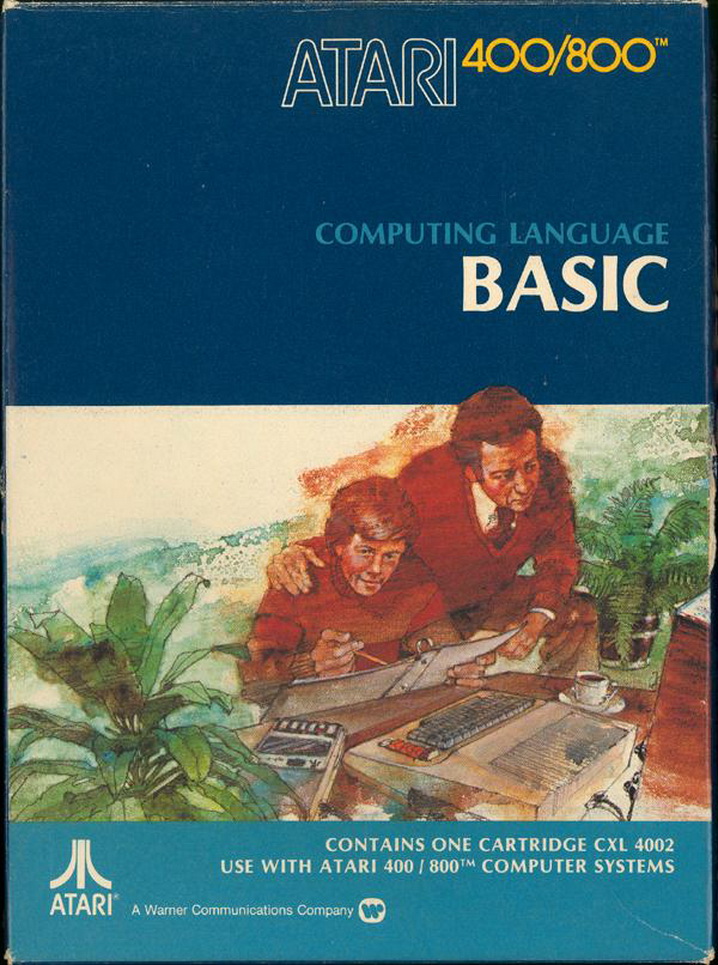 |
Design notes#
Atari BASIC has some key differences with the more common MS-derived BASICs found on most contemporary machines. Generally, one can describe Atari BASIC's design philosophy as "modeless" and "orthogonal".Most BASICs of the era had the concept of "immediate mode" and "program mode", and some commands could only be used in one mode or the other. A good example in MS BASIC is the LIST command, which could only be used in immediate mode, at the "command line". Atari BASIC removed this limitation, one could write a program consisting of 10 LIST.
Additionally, most BASICs had commands that read input or produced output, for example, the INPUT can be thought of as the opposite of PRINT. Atari BASIC was orthogonal in that every such command had a partner. For instance, LIST produces output, so the new command ENTER reversed this, reading a program listing from a device. This opened up a number of possible overlay techniques that other BASICs lacked.
The most noticeable difference between Atari BASIC and MS-derived versions is the string handling. Atari BASIC used a greatly simplified system of character-arrays instead of the dynamic strings in MS. This meant that all strings had to be predefined using DIM, and their length could not be changed during run-time. There are a number of advantages to this approach, notably speed and lower memory usage, but this means conversion of standard programs from MS listings may be difficult.
What's missing#
In addition to differences like string handling, Atari BASIC also lacked some of the less-used features found in MS BASIC. Among these are...- TAB and SPC, for formatting output
- PRINT USING, which formatted output (rarely supported on small machines)
- INPUT "prompt", A$, which printed the prompt and placed the cursor at the end
- INKEY$, which read the keyboard without pausing (unlike INPUT)
- DEF FN, which defines mathematical functions
Most 3rd party BASICs for the Atari added many of these features, and more.
What's new#
To allow BASIC programmers access to the advanced features of the system, Atari BASIC added commands for defining the GRAPHICS, changing COLORs, MOVEing and drawing a DRAWTO, playing SOUND, and others.Source Code#
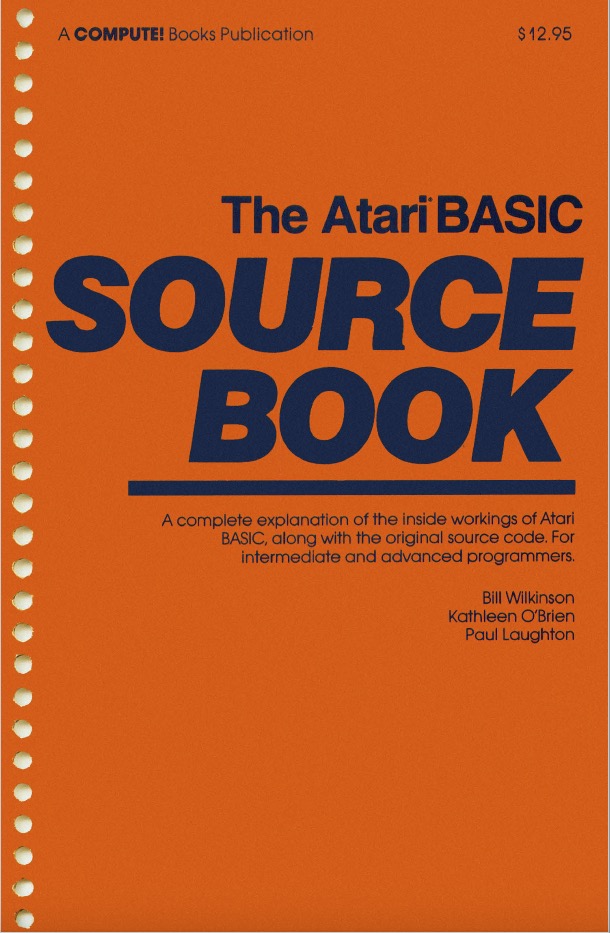 |
 ; size: 76.8 MB ; 316 pages
; size: 76.8 MB ; 316 pages
ROM-Images#
 |
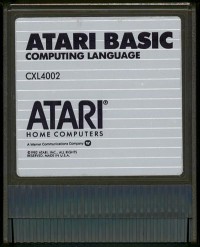 |
- Atari Basic Rev. A.rom
 ; ? PEEK(43234) should return: 162
; ? PEEK(43234) should return: 162
- Atari Basic Rev. B.rom
 ; ? PEEK(43234) should return: 96
; ? PEEK(43234) should return: 96
- Atari Basic Rev. C.rom
 ; ? PEEK(43234) should return: 234
; ? PEEK(43234) should return: 234
- Monkey_Wrench_with_BASIC_(Rev._C).rom
 ; both roms in just one 16 KiB file
; both roms in just one 16 KiB file
- Monkey_Wrench_II_OS-B_right_v1.rom
 ; thanks to serious computerist
; thanks to serious computerist , we really appreciate! :-)
, we really appreciate! :-)
- Monkey_Wrench_II_OS-B_right_v2.rom
 ; thanks to serious computerist
; thanks to serious computerist , we really appreciate! :-)
, we really appreciate! :-)
- Monkey Wrench II (OS-B, right, v1) with BASIC Rev. C.rom
 ; both roms in just one 16 KiB file
; both roms in just one 16 KiB file
- Monkey Wrench II (OS-B, right, v2) with BASIC Rev. C.rom
 ; both roms in just one 16 KiB file
; both roms in just one 16 KiB file
- Monkey_Wrench_II_XL_with_BASIC_(Rev._C).rom
 ; both roms in just one 16 KiB file
; both roms in just one 16 KiB file
To create one 16 KiB-ROM out of 2 8 KiB ROMs, use the following method:
Windows:
Go to the CMD shell and there to the directory, where the 2 files are, which should be combined, then type:
copy /b monkey.rom+basic.rom allinone16k.rom
and the resulting rom file can be found in the same directory.
Unix/Mac:
Start application shell/Terminal and then type cd and a blank. Drag the folder, in which the 2 files are, directly behind the blank. Check with typing ls -a, whether the 2 files can be seen. Then type:
cat monkey.rom basic.rom > allinone16k.rom
and the resulting rom file can be found in the same directory.
CAR-Images#
- Atari_Basic_Rev._A.car
 ; ? PEEK(43234) should return: 162
; ? PEEK(43234) should return: 162
- Atari_Basic_Rev._B.car
 ; ? PEEK(43234) should return: 96
; ? PEEK(43234) should return: 96
- Atari_Basic_Rev._C.car
 ; ? PEEK(43234) should return: 234
; ? PEEK(43234) should return: 234
- The Monkey Wrench.car
 Tool for better editing Basic programs, version I
Tool for better editing Basic programs, version I
- The Monkey Wrench II.car
 Tool for better editing Basic programs, version II v2
Tool for better editing Basic programs, version II v2
- Monkey_Wrench_with_BASIC_(Rev._C).car
 ; both cartridges in just one 16 KiB file
; both cartridges in just one 16 KiB file
- Monkey_Wrench_II_OS-B_right_v1.car
 ; thanks to serious computerist
; thanks to serious computerist , we really appreciate! :-)
, we really appreciate! :-)
- Monkey_Wrench_II_OS-B_right_v2.car
 ; thanks to serious computerist
; thanks to serious computerist , we really appreciate! :-)
, we really appreciate! :-)
- Monkey_Wrench_II_XL_with_BASIC_(Rev._C).car
 ; both cartridges in just one 16 KiB file. This is a patched BASIC, when initialized jumps to $8002 (right cartridge). Only this way it is runnig on a XL machine.
; both cartridges in just one 16 KiB file. This is a patched BASIC, when initialized jumps to $8002 (right cartridge). Only this way it is runnig on a XL machine.
Manuals#
- Atari Basic Reference Manual Rev. A (1980)
 ; size: 77.7 MB ; 122 pages
; size: 77.7 MB ; 122 pages
- Atari Basic Reference Manual-Product Update-C061038 Rev. A, Errata for the above manual (1982)
 ; size: 4.2 MB ; 6 pages
; size: 4.2 MB ; 6 pages
- Atari Basic Reference Manual Rev. C (1983)
 ; size: 47.9 MB ; 134 pages
; size: 47.9 MB ; 134 pages
- Atari BASIC - Bob_Albrecht, LeRoy Finkel and Jerald R. Brown (1979)
 ; size: 80.9 MB ; OCR ; 348 pages
; size: 80.9 MB ; OCR ; 348 pages
- Atari_Basic-Richard_Haskell (1983)
 ; size: 74.7 MB ; OCR ; 196 pages
; size: 74.7 MB ; OCR ; 196 pages
- Atari BASIC-XL Edition - Bob_Albrecht, LeRoy Finkel and Jerald R. Brown (1985)
 ; size: 86.5 MB ; OCR ; 404 pages
; size: 86.5 MB ; OCR ; 404 pages
- ATARI BASIC-Handbuch für Selbststudium und Praxis-BOB ALBRECHT, Le Roy Finkel, JERALD BROWN
 ; Größe: 44,8 MB ; OCR ; 214 Doppelseiten
; Größe: 44,8 MB ; OCR ; 214 Doppelseiten
- ATARI Basic Leitfaden
 ; Größe: 5,2 MB ; 11 Seiten
; Größe: 5,2 MB ; 11 Seiten
- Atari BASIC - Quick Reference Guide - Gilbert Held
 ; size: 10.4 MB ; 8 pages
; size: 10.4 MB ; 8 pages
- OSS Quick reference card for Atari Basic
 ; size: 3.4 MB ; 8 pages ; thank you so much Bill Lange for finding this very rare cards. :-)
; size: 3.4 MB ; 8 pages ; thank you so much Bill Lange for finding this very rare cards. :-)
- Atari Basic Referenz-Karten
 ; Größe: 3,1 MB ; OCR ; 271 Seiten
; Größe: 3,1 MB ; OCR ; 271 Seiten
- Atari BASIC Source Book (2006)
 ; size: 10.4 MB ; OCR ; 80 pages ; converted 2006 by Andreas Bertelmann for ABBUC ; thank you Andreas
; size: 10.4 MB ; OCR ; 80 pages ; converted 2006 by Andreas Bertelmann for ABBUC ; thank you Andreas
- Monkey_Wrench_-_Manual.pdf
 ; size: 67.5 MB ; thanks to serious computerist
; size: 67.5 MB ; thanks to serious computerist , we really appreciate! :-)
, we really appreciate! :-)
- Monkey_Wrench_II_-_Manual.pdf
 ; size: 2.5 MB ; thanks to serious computerist
; size: 2.5 MB ; thanks to serious computerist , we really appreciate! :-)
, we really appreciate! :-)
- The major differences between the Monkey Wrench II and Monkey Wrench II-XL cartridges
 ; thanks to serious computerist
; thanks to serious computerist , we really appreciate! :-)
, we really appreciate! :-)
Atari Basic Keywords#
An incredible good site for all Atari BASIC keywords ; thank you ABBUC, greatly appreciated! :-)
; thank you ABBUC, greatly appreciated! :-)
 |
Abbreviations#
| Command | Abbreviation |
|---|
| BYE | B. |
|---|---|
| CLOAD | CLOA. |
| CLOSE | CL. |
| COLOR | C. |
| CONT | CON. |
| CSAVE | CS. |
| DATA | D. |
| DEG | DE. |
| DIM | DI. |
| DOS | DO. |
| DRAWTO | DR. |
| ENTER | E. |
| FOR | F. |
| GET | GE. |
| GOTO | G. |
| GOSUB | GOS. |
| GRAPHICS | GR. |
| INPUT | I. |
| LET | LE. |
| LIST | L. |
| LOAD | LO. |
| LOCATE | LOC. |
| LPRINT | LP. |
| NEXT | N. |
| NOTE | NO. |
| OPEN | O. |
| PLOT | PL. |
| POINT | P. |
| POKE | POK. |
| POSITION | POS. |
| PR. | |
| PUT | PU. |
| RAD | RA. |
| READ | REA. |
| REM | . |
| RESTORE | RES. |
| RETURN | RET. |
| RUN | RU. |
| SAVE | S. |
| SETCOLOR | SE. |
| SOUND | SO. |
| STATUS | ST. |
| STOP | STO. |
| TRAP | T. |
| XIO | X. |
Atari Basic Error Codes#
2 - INSUFFICIENT MEMORY3 - BAD VALUE
4 - TOO MANY VARIABLES
5 - STRING LENGHT ERROR
6 - OUT OF DATA
7 - BAD LINE NUMBER
8 - INPUT ERROR
9 - DIMENSION ERROR
10 - STACK OVERFLOW
11 - OVERFLOW/UNDERFLOW
12 - LINE NOT FOUND
13 - NO MATCHING FOR
14 - LINE TOO LONG
15 - GOSUB/FOR DELETED
16 - RETURN ERROR
17 - SYNTAX ERROR
18 - INVALID CHARACTER
19 - PROGRAM TOO LONG
20 - BAD DEVICE NUMBER
21 - LOAD FILE ERROR
Atari Basic Course: An Invitation to Programming 1-3#
- Course 1: An Invitation to Programming 1 - Fundamentals of Basic Programming CX4101
- Course 2: An Invitation to Programming 2 - Writing Programs one and two CX4106
- Course 3: An Invitation to Programming 3 - Introduction to Sound and Graphics CX4117
Atari Basic Kurs (deutsch): Teil 1 und 2 sind vorhanden, Teil 3 wurde leider nie fertig#
- Kurs 1: Programmieren leicht gemacht-Lernen Sie BASIC mit Dagmar Berghoff-TXG4110
- Kurs 2: Noch mehr BASIC-Lernen Sie BASIC mit Dagmar Berghoff-TXG 55007
- Kurs 3: BASIC für Fortgeschrittene-Lernen Sie BASIC mit Dagmar Berghoff
Source and Tools#
- Extended Atari Basic
- RPM810 Program to measure 810 disk speed
- Infoline Infoline for BASIC and ACTION!
- ST Mouse Driver for Basic
- Boolean Logic in BASIC
- Atari Basic Special Clear Screen (german)
- How to find the revision number of Atari Basic
- Basic Fast Stack and Fast Jump
- BASIC on-off from DOS XL commandline
- Page Flip Routine for Basic
- RAM Move Routine for Basic
- Basic Program Lister
- UUDecoder
- Create Data-Statements from binary load files
- Schnelle Player Bewegung in Basic (german)
- REV.B TO REV.C CONVERTER.txt
 Atari Basic Rev. B to Rev. C Converter as TXT file
Atari Basic Rev. B to Rev. C Converter as TXT file
- RevB2C.atr
 Atari Basic Rev. B to Rev. C Converter as ATR-image
Atari Basic Rev. B to Rev. C Converter as ATR-image
References#
- Atari BASIC Article in Wikipedia

- Atari Basic vs. Commodore C64 Basic vs. Apple II Basic
- Atari BASIC: the good, the bad and the ugly

Pictures#
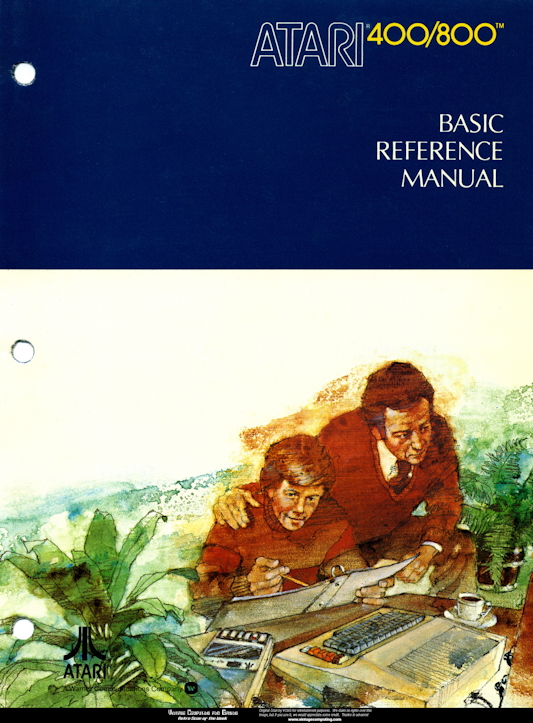 |
 ; size: 77.7 MB ; 122 pages
; size: 77.7 MB ; 122 pages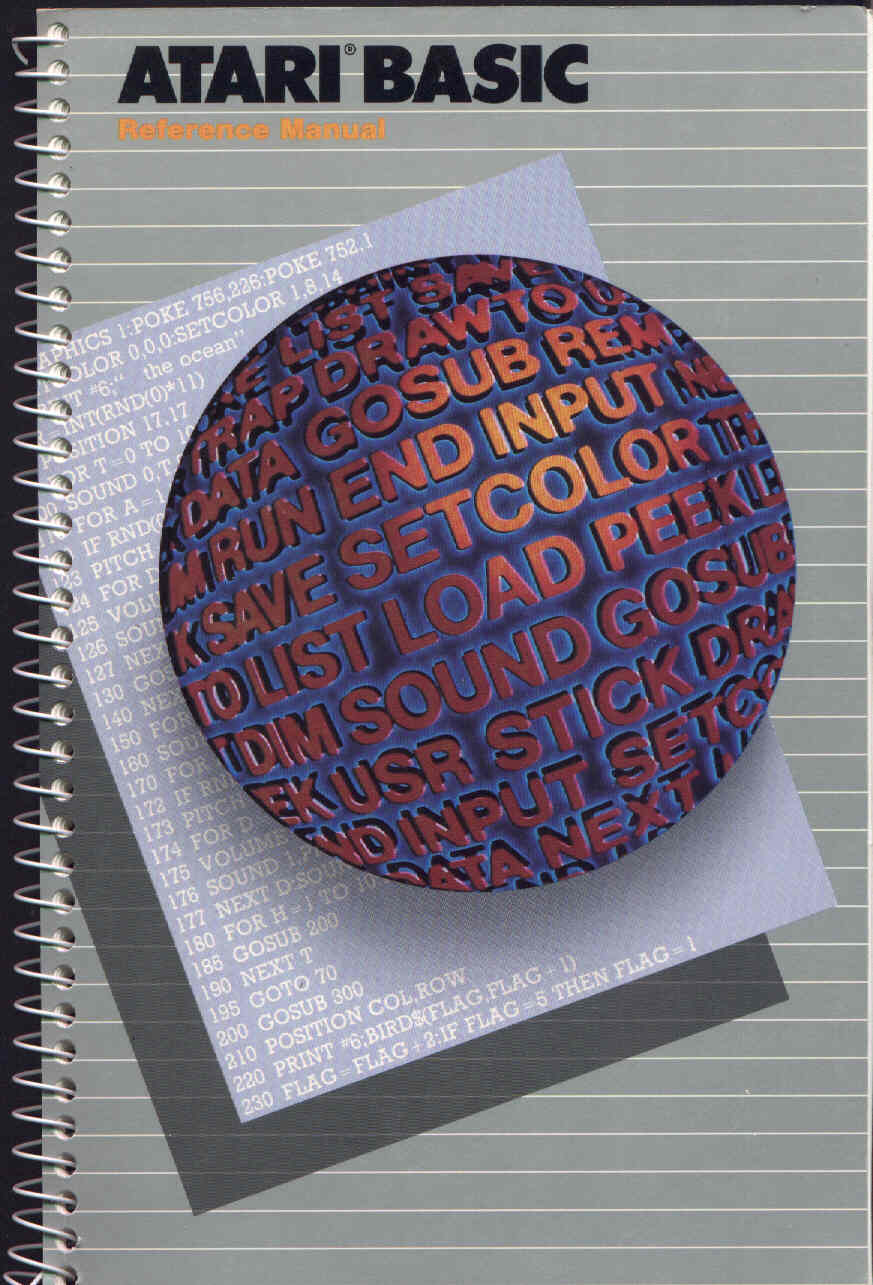 |
 ; size: 47.9 MB ; 134 pages
; size: 47.9 MB ; 134 pages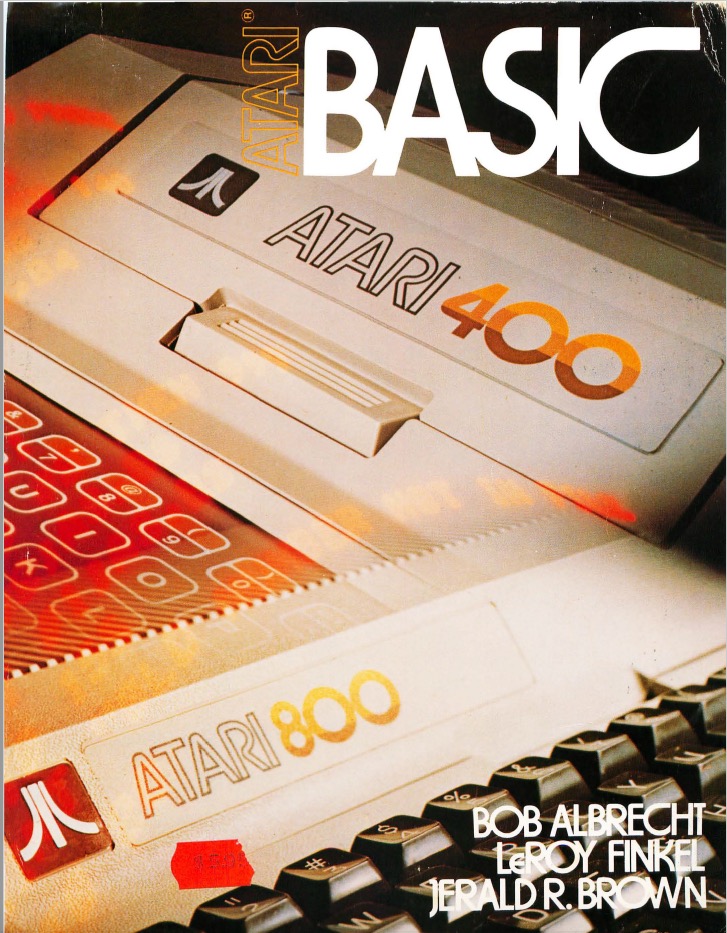 |
 ; size: 80.9 MB ; OCR ; 348 pages
; size: 80.9 MB ; OCR ; 348 pages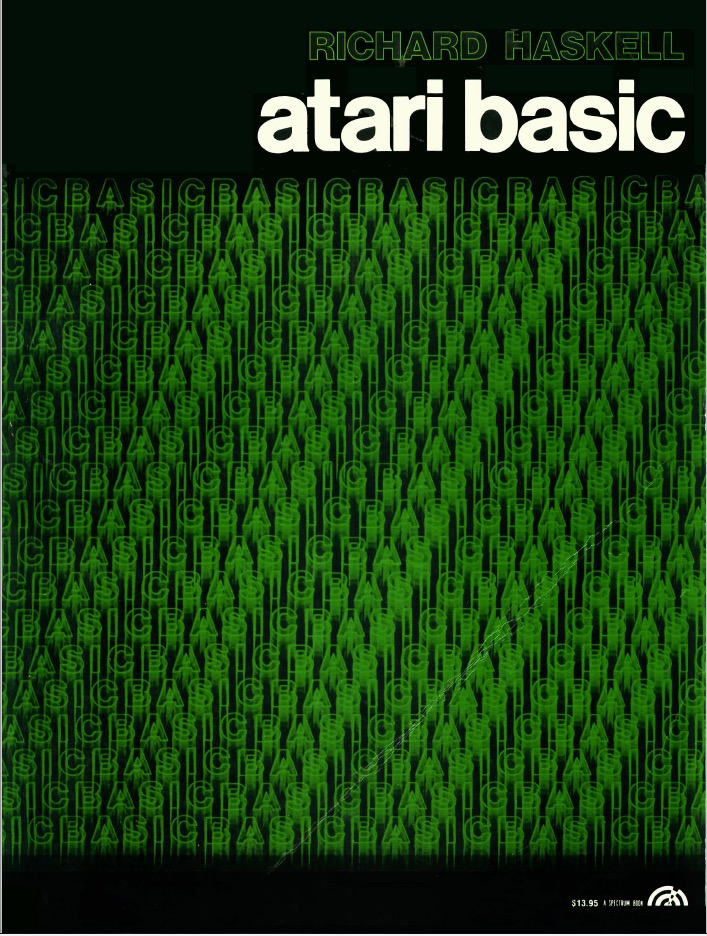 |
 ; size: 74.7 MB ; OCR ; 196 pages
; size: 74.7 MB ; OCR ; 196 pages |
 ; size: 86.5 MB ; OCR ; 404 pages
; size: 86.5 MB ; OCR ; 404 pages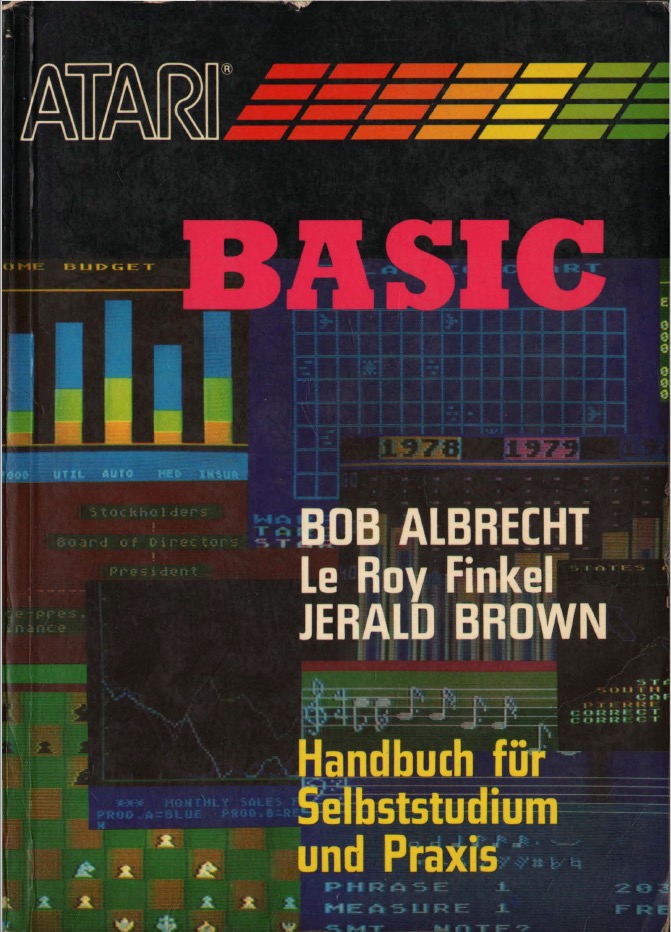 |
 ; Größe: 44,8 MB ; OCR ; 214 Doppelseiten
; Größe: 44,8 MB ; OCR ; 214 Doppelseiten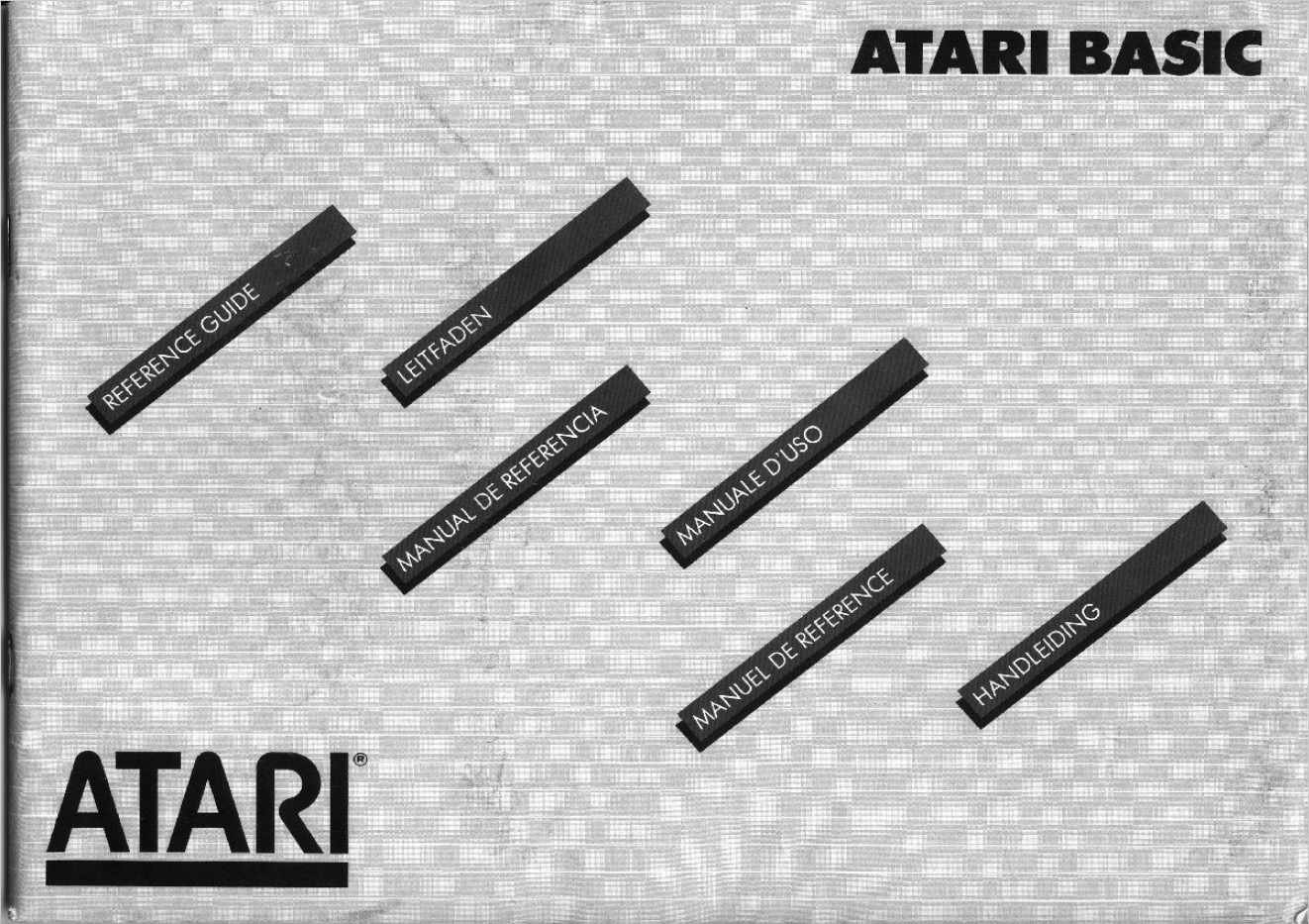 |
 ; Größe: 5,2 MB ; 11 Seiten
; Größe: 5,2 MB ; 11 Seiten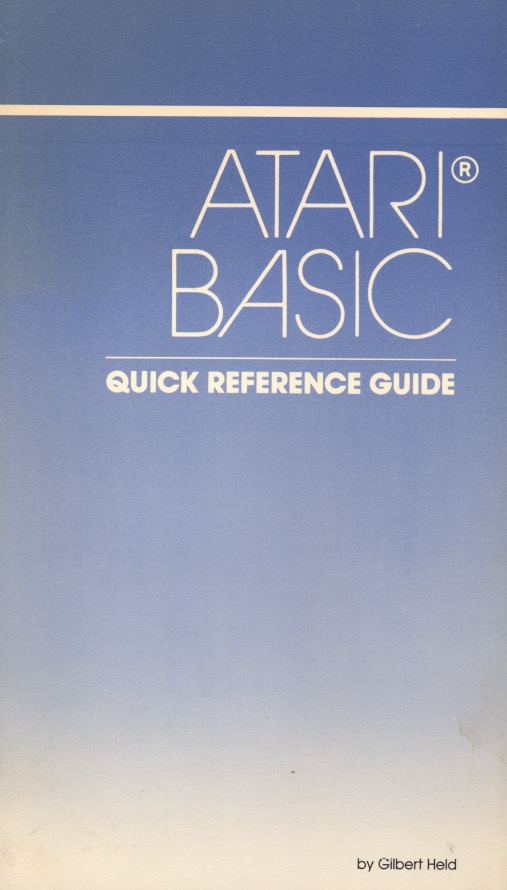 |
 ; size: 10.4 MB ; 8 pages
; size: 10.4 MB ; 8 pages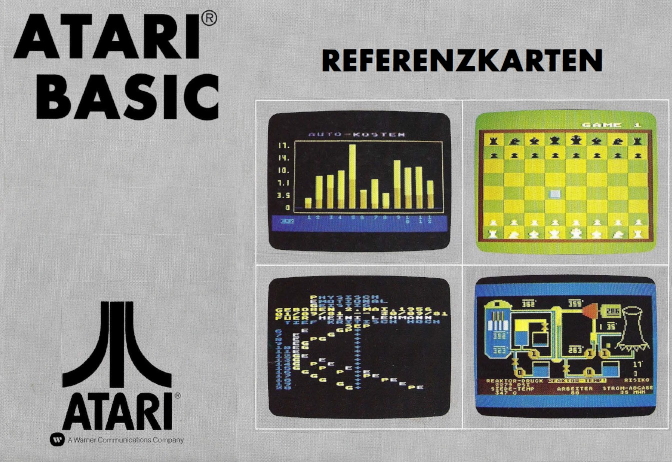 |
 ; Größe: 3,1 MB ; OCR ; 271 Seiten
; Größe: 3,1 MB ; OCR ; 271 Seiten